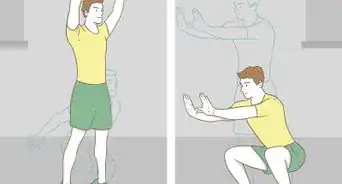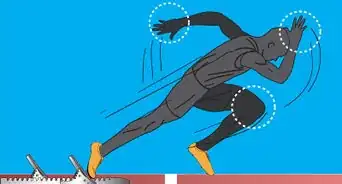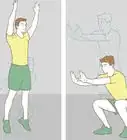wikiHow is a “wiki,” similar to Wikipedia, which means that many of our articles are co-written by multiple authors. To create this article, 55 people, some anonymous, worked to edit and improve it over time.
There are 7 references cited in this article, which can be found at the bottom of the page.
This article has been viewed 286,376 times.
Learn more...
Hurdling is usually done in different events: 60 meter hurdles, 80 meter hurdles, 100 meter hurdles, 110 meter hurdles, 300 meter hurdles, and 400 meter hurdles. Hurdlers compete at almost any track-and-field meet, from middle school events, all the way to the Olympics. Hurdling is a great sport that requires good fitness, flexibility, upper body strength, and, most of all, perseverance and determination.
Steps
Before the Event
-
1
-
2Run a few practice hurdles. Make sure you have your lead and trail legs figured out before the race starts. The lead leg is the leg that goes over the hurdle extended before your body.[3]
- The lead leg is usually the leg that people use to catch themselves while falling. People can trip forward or have someone push them to find which leg makes sense for them. Many people also switch back and forth between legs which is a possibility.
Advertisement -
3Count your steps. The number of steps you take will depend on how long the course is, as well as on the person's height, weight, speed, the height of their jump, the length of the jump, and even their usual sprinting stride length. You might take 4-5 steps before the first hurdle on a 60m course and 6-8 on a 100m course.
- Steps in between will be different for every person. One thing to note, however, is that if the hurdles are evenly spaced, you should have the same amount of steps in between every hurdle. You should not take three huge steps and then eight little steps... Instead maybe take 6 regular stride steps.
- Picture yourself going barely an inch over the jump. You might find that when you try to get as low as possible, you end up clearing the jump by plenty, while increasing your speed. Practice really does make perfect! And leaning forward opens a whole new world of speed.
During The Event
-
1
-
2Do not slow down at the first hurdle: your momentum is what will carry you over. When you are about 1 to 2 feet away from the hurdle, bring the foot that isn't on the ground (lead leg) up to your butt and then quickly extend it up over the hurdle.
-
3Drag the trail leg sideways over the side of the hurdle after the lead leg has passed over. The ankle and the knee are supposed to be the same distance from the ground. The straight line along the shin/calf in between the ankle and the knee must be parallel to the ground and must be parallel to the hurdle.[5]
-
4Continue the race, trying to pick up speed towards the end. Clearing the last hurdle can be difficult, but if you push yourself too much, it will be no problem, but it can hurt in the end.
Community Q&A
-
QuestionI am afraid of jumping over hurdles, what can I do to conquer my fear?
 Community AnswerTry jumping next to it, just to realize that you can make it over the hurdle easily. Then try stepping over it and finally take a deep breath and leap over it, no problem! Remember that hurdles are made to fall if you don't make it, keeping things safer for you and allowing you to keep running.
Community AnswerTry jumping next to it, just to realize that you can make it over the hurdle easily. Then try stepping over it and finally take a deep breath and leap over it, no problem! Remember that hurdles are made to fall if you don't make it, keeping things safer for you and allowing you to keep running. -
QuestionI'm good at them, but I get so scared when I perform in front of people. What should I do?
 Community AnswerFirst of all, you aren't out there racing for the other people; you're racing for yourself. Even if you mess up, nobody will remember it the next day. Keep in mind that it takes time, practice and perseverance. Don't stress -- your coaches wouldn't put you in that event if they didn't think you could do it.
Community AnswerFirst of all, you aren't out there racing for the other people; you're racing for yourself. Even if you mess up, nobody will remember it the next day. Keep in mind that it takes time, practice and perseverance. Don't stress -- your coaches wouldn't put you in that event if they didn't think you could do it. -
QuestionHow do I improve my hurdling speed?
 Community AnswerTake longer strides and try not to stutter step before the hurdle. Also, consider timing yourself while running, and beating your time each session. For example, if you have a time of 35.2, try to shave off those extra 5 seconds and keep going with that.
Community AnswerTake longer strides and try not to stutter step before the hurdle. Also, consider timing yourself while running, and beating your time each session. For example, if you have a time of 35.2, try to shave off those extra 5 seconds and keep going with that.
Warnings
- When landing from clearing a hurdle, make sure your feet are within your designated lane. Even if no one is beside you, you will be disqualified.⧼thumbs_response⧽
- When hurdling in a meet, be sure you move your arms correctly when clearing the hurdle. (arm opposite of lead leg bent across your chest, like your folding your arms with one arm, and the other arm bent behind your back in the same manner) If you do not, and you let your arms swing out haphazardly, you may hit, and possibly injure the hurdler in the lane next to you.⧼thumbs_response⧽
- Make sure that you are familiar with the basics of hurdling, including what leg is your dominant/lead leg, which foot you have forward in the blocks, how many steps you are capable of getting before the first hurdle and between hurdles, and technique.⧼thumbs_response⧽
- Hurdling may cause injury, including pulled muscles, or falls.⧼thumbs_response⧽
References
- ↑ https://www.youtube.com/watch?v=a1ArZFZjybs
- ↑ https://www.webmd.com/fitness-exercise/hamstring-strain#2-5
- ↑ https://www.liveabout.com/beginners-track-and-field-learning-hurdles-3258846
- ↑ https://www.myactivesg.com/Sports/Athletics/Training-Method/Athletics-for-beginners/How-do-I-sprint-faster
- ↑ https://www.myactivesg.com/Sports/Athletics/Training-Method/Athletics-for-beginners/How-to-improve-your-hurdles-technique
- https://www.youtube.com/watch?v=TYjuaIwS07c
- Videos provided by Jaret Campisi
About This Article
Hurdles can be tricky, but with a little confidence and the right timing, you’ll be clearing them in no time. Before you jump over a hurdle, figure out which leg is your lead leg and which is your trail leg. Your lead leg is generally the leg that you use to catch yourself when you fall. When you run towards the hurdle, don’t slow down, as you’ll need your momentum to clear it. As you near the hurdle, take a step with your trail leg, then launch your lead leg over the hurdle. Then, pull your trail leg sideways and over the hurdle. Once you feel comfortable jumping over 1 hurdle, figure out the exact number of steps you need to take between each hurdle so you can get a rhythm down as you run. To learn how to push yourself during a race, read on!

























































